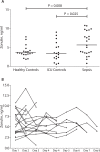Increased plasma zonulin in patients with sepsis
- PMID: 23457771
- PMCID: PMC3900088
- DOI: 10.11613/bm.2013.013
Increased plasma zonulin in patients with sepsis
Abstract
Introduction: Zonulin is a eukaryotic protein structurally similar to Vibrio cholerae's zonula occludens toxin. It plays an important role in the opening of small intestine tight junctions. The loss of gut wall integrity during sepsis might be pivotal and has been described in various experimental as well as human studies. Increased levels of zonulin could be demonstrated in diseases associated with increased intestinal inflammation, such as celiac disease and type 1 diabetes. We therefore investigated the role of plasma levels of zonulin in patients with sepsis as a non-invasive marker of gut wall integrity.
Materials and methods: Plasma level of zonulin was measured in 25 patients with sepsis, severe sepsis or septic shock according to ACCP/SCCM criteria at the first day of diagnosed sepsis. 18 non-septic post-surgical ICU-patients and 20 healthy volunteers served as control. Plasma levels were determined by using commercially available ELISA kit. Data are given as median and interquartile range (IQR).
Results: Significantly higher plasma concentration of zonulin were found in the sepsis group: 6.61 ng/mL (IQR 3.51-9.46), as compared to the to the post-surgical control group: 3.40 ng/mL (IQR 2.14-5.70) (P = 0.025), as well as to the healthy group: 3.55 ng/mL (IQR 3.14-4.14) (P = 0.008).
Conclusion: We were able demonstrate elevated levels of plasma zonulin, a potential marker of intestinal permeability in septic patients. Increased zonulin may serve as an additional mechanism for the observed increased intestinal permeability during sepsis and SIRS.
Figures

References
-
- Labelle A, Juang P, Reichley R, Micek S, Hoffmann J, Hoban A, et al. The determinants of hospital mortality among patients with septic shock receiving appropriate initial antibiotic treatment. Crit Care Med. 2012;40:2016–21. http://dx.doi.org/10.1097/CCM.0b013e318250aa72. - DOI - PubMed
-
- Leaphart CL, Tepas JJ. The gut is a motor of organ system dysfunction. Surgery. 2007;141:563–9. http://dx.doi.org/10.1016/j.surg.2007.01.021. - DOI - PubMed
-
- Fink MP. Intestinal epithelial hyperpermeability: update on the pathogenesis of gut mucosal barrier dysfunction in critical illness. Curr Opin Crit Care. 2003;9:143–51. http://dx.doi.org/10.1097/00075198-200304000-00011. - DOI - PubMed
-
- Clark JA, Coopersmith CM. Intestinal crosstalk: a new paradigm for understanding the gut as the “motor” of critical illness. Shock. 2007;28:384–93. http://dx.doi.org/10.1097/shk.0b013e31805569df. - DOI - PMC - PubMed
-
- Shen L. Tight junctions on the move: molecular mechanisms for epithelial barrier regulation. Ann N Y Acad Sci. 2012;1258:9–18. http://dx.doi.org/10.1111/j.1749-6632.2012.06613.x. - DOI - PMC - PubMed
Publication types
MeSH terms
Substances
LinkOut - more resources
Full Text Sources
Other Literature Sources
Medical

